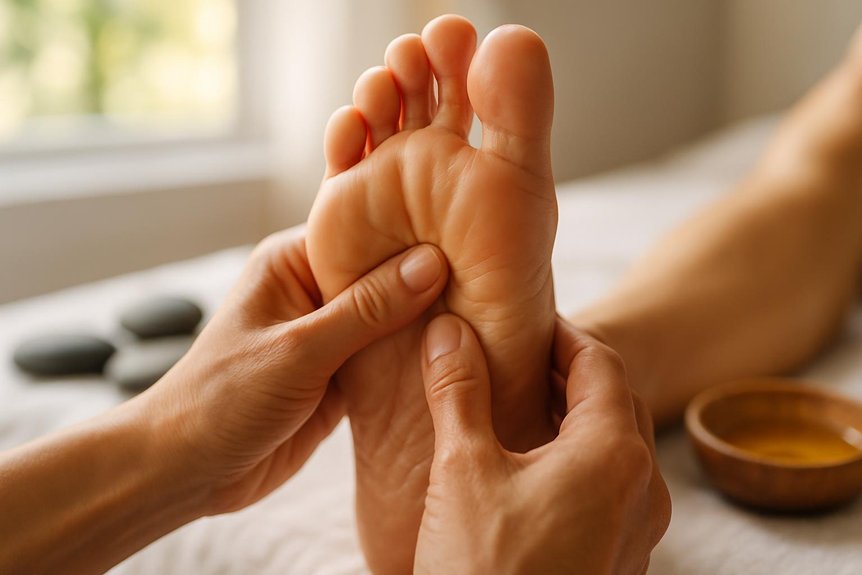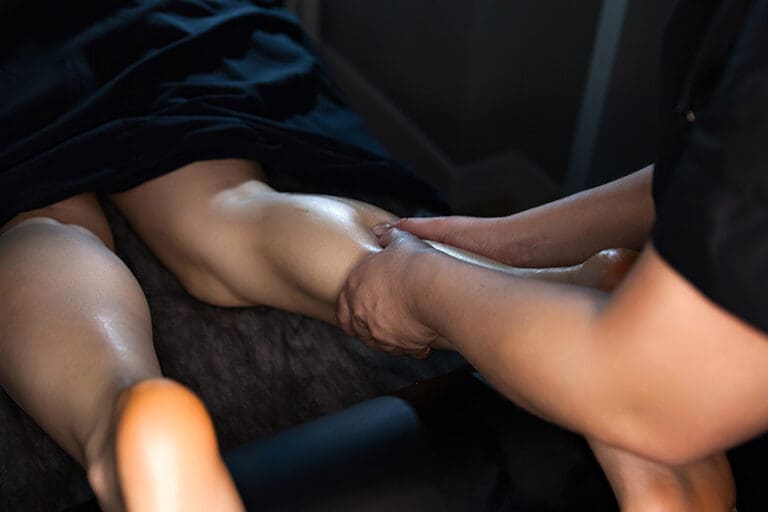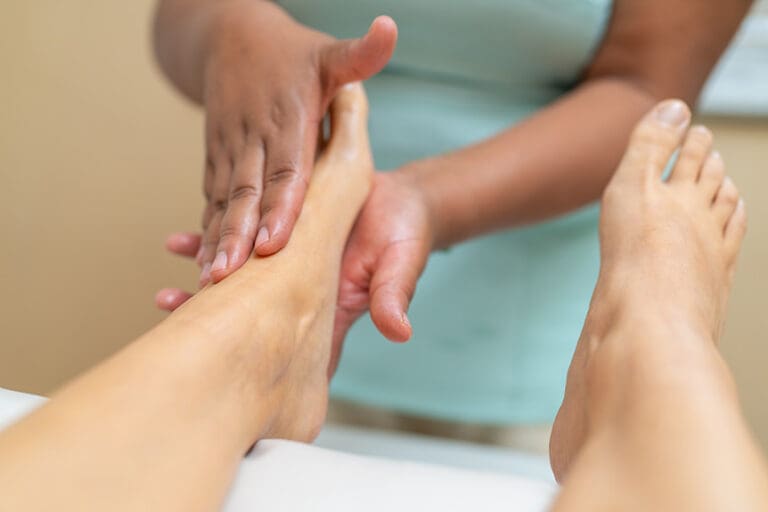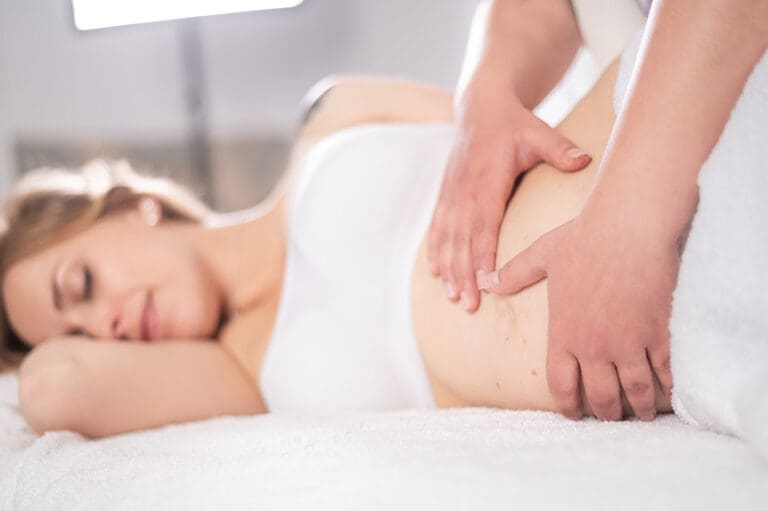It is a therapeutic technique that applies targeted pressure to specific points on the feet, hands, or ears, stimulating the nervous system and promoting the body’s natural healing processes. This method helps reduce stress, improve circulation, modulate autonomic functions such as heart rate and blood pressure, and foster overall relaxation. Clients often report enhanced wellbeing and relief from tension-related discomfort. Further information reveals how this therapy achieves these physiological effects and the benefits clients may experience during a session.
Understanding the Principles of this Therapy
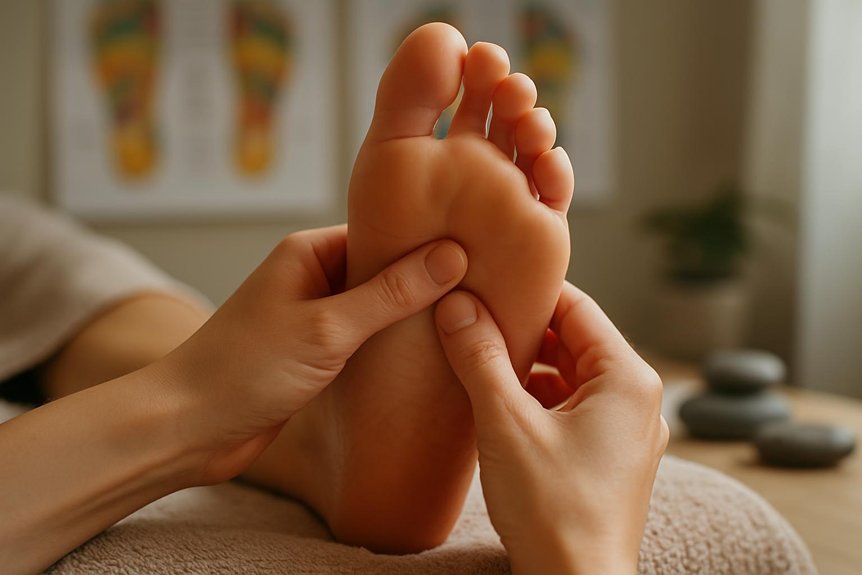
Reflexology is a therapeutic technique based on the principle that specific points on the feet, hands, and ears correspond to various organs and systems within the body. This modality employs targeted pressure to these reflex zones, aiming to stimulate the body’s innate healing mechanisms and promote equilibrium.
At Spa & Massage, practitioners utilise detailed zone therapy charts to accurately identify the zones corresponding to clients’ concerns, ensuring a focused and personalised session. The foundations of this therapy are rooted in anatomical and neurological relationships, providing a structured approach to wellness.
While evidence continues to evolve, clinical observations suggest that precise touch can influence comfort levels and foster deep relaxation. For individuals seeking a gentle, non-invasive route to support wellbeing, this therapy offers a mindful and considered practice within a tranquil setting. Similar to pregnancy massage benefits, foot reflex treatment can provide significant comfort and relaxation for expecting mothers seeking natural support during pregnancy.
How This Affects the Body
Stimulation of reflex points on the feet, hands, or ears initiates a cascade of physiological responses throughout the body. Research indicates that targeted pressure on these regions may influence the nervous system, promoting relaxation and modulating stress levels.
Sensory nerve pathways convey signals to the central nervous system, potentially affecting autonomic processes such as heart rate, blood pressure, and respiration.
At Spa & Massage, therapists apply precise techniques to activate specific reflex zones, aiming to support homeostasis and enhance the body’s innate regulatory mechanisms.
Circulatory and lymphatic flow may also improve, facilitating the removal of metabolic waste and supporting tissue nourishment.
This integrated approach underpins the therapeutic potential of this practice, providing a foundation for both physical and emotional equilibrium within a safe, expert-led environment.
Common Benefits Experienced by Clients
A diverse range of positive outcomes is frequently reported by individuals who undergo this sessions at Spa & Massage clinics. Clients often describe a marked reduction in stress and enhanced relaxation, which can foster a sense of emotional equilibrium.
Many experience improved sleep quality, citing deeper rest following treatments. Reflex Point Massage is also associated with alleviation of tension-related discomfort, particularly in the feet and lower limbs.
Some clients note enhanced circulation and a general feeling of vitality after sessions. Reports suggest that this treatment may contribute to a reduction in headaches and promote a greater sense of overall wellbeing.
These benefits are commonly observed within the tranquil, supportive environment cultivated at Spa & Massage, where therapists tailor each session to clients’ unique physical and emotional needs.
Techniques Used by Professional Reflexologists
Recognising the positive outcomes frequently reported by clients, Spa & Massage employs specific massage techniques grounded in anatomical knowledge and therapeutic expertise. Professional reflexologists apply precise pressure to mapped zones on the feet, hands, or ears, using their thumbs and fingers in controlled, rhythmic motions.
The thumb-walking technique, a hallmark of zone therapy at Spa & Massage, involves small, caterpillar-like movements across the reflex points to stimulate nerve pathways and encourage physiological responses.
Therapists may also integrate gentle kneading, circular movements, and stretching to enhance comfort and effectiveness. Each session is tailored by evaluating individual needs and sensitivities, ensuring adjustments for ideal results.
This meticulous, attentive approach fosters both physical and emotional well-being, creating a deeply personal and restorative experience for every client.
Reflexology and Stress Relief
This has been shown to modulate the autonomic nervous system, resulting in measurable reductions in physiological markers of stress.
By targeting specific reflex points, practitioners at Spa & Massage facilitate the body’s relaxation response, which can lead to decreased heart rate and lower cortisol levels.
This evidence-based approach supports clients seeking effective strategies for managing stress and enhancing overall well-being.
Calming the Nervous System
The application of targeted pressure to specific reflex points on the feet, hands, or ears has been shown to promote a calming effect on the nervous system, making it an effective method for managing stress and encouraging relaxation.
This therapy is believed to modulate autonomic nervous system activity, reducing sympathetic arousal and fostering a parasympathetic state. This physiological shift can result in lower heart rate, decreased blood pressure, and diminished muscle tension.
At Spa & Massage clinics, therapists employ refined massage techniques to soothe neural pathways and support the body’s natural equilibrium. Many clients report a tangible sense of tranquility following sessions, which is consistent with evidence suggesting that this may help balance neurological responses.
This gentle yet purposeful intervention offers a supportive approach to nervous system regulation.
Promoting Relaxation Responses
While chronic stress can disrupt physiological balance, targeted massage interventions have demonstrated potential in eliciting the body’s relaxation responses.
Research indicates that this therapy may activate the parasympathetic nervous system, thereby reducing heart rate, lowering blood pressure, and diminishing circulating stress hormones such as cortisol.
At Spa & Massage, therapists employ precise pressure techniques on specific reflex points, aiming to encourage muscular relaxation and mental calm.
Clients often report a sensation of warmth and tranquility, which aligns with evidence supporting enhanced endorphin release during massage sessions.
These physiological changes foster a restorative state, counteracting the effects of daily stressors.
Supporting Overall Wellbeing With This Therapy
A holistic approach to wellness often incorporates therapies that address both physical and mental health, and this practice is recognised as an effective modality in this regard.
Clinical studies suggest that this therapy may help regulate nervous system activity, promote circulation, and encourage homeostasis within the body. These physiological effects can contribute to reduced stress, improved sleep quality, and enhanced mood, supporting a sense of overall wellbeing.
At Spa & Massage, therapists integrate this into personalised wellness plans, acknowledging the interconnectedness of body and mind.
Many clients report increased energy levels, greater emotional balance, and a renewed sense of vibrancy following regular sessions.
What to Expect During a Session at Spa & Massage
Upon arrival at Spa & Massage, clients are welcomed into a calm, supportive environment designed to foster relaxation and comfort.
Each session begins with a brief consultation, allowing the therapist to understand specific health goals and tailor the treatment accordingly.
Clients are then invited to recline as the therapist cleanses and assesses the feet.
Using precise thumb and finger techniques, the therapist applies targeted pressure to mapped reflex zones, aiming to stimulate corresponding organs and systems.
The experience is typically described as deeply soothing, with many clients reporting a sense of gentle release and holistic balance.
Throughout the session, therapists at Spa & Massage remain attentive to comfort cues, ensuring a personalised approach that encourages both physical and emotional wellbeing.
Conclusion
Much like a skilled gardener tending to a complex landscape, this practice cultivates balance and nurtures wellbeing within the body’s intricate pathways. Grounded in anatomical correspondence and supported by clinical observations, this therapy systematically addresses stress and tension, fostering an environment where the body’s innate restorative mechanisms may flourish. At Spa & Massage, zone therapy stands as a practiced steward, guiding clients along the path toward equilibrium—inviting both body and mind into a state of renewed harmony.
